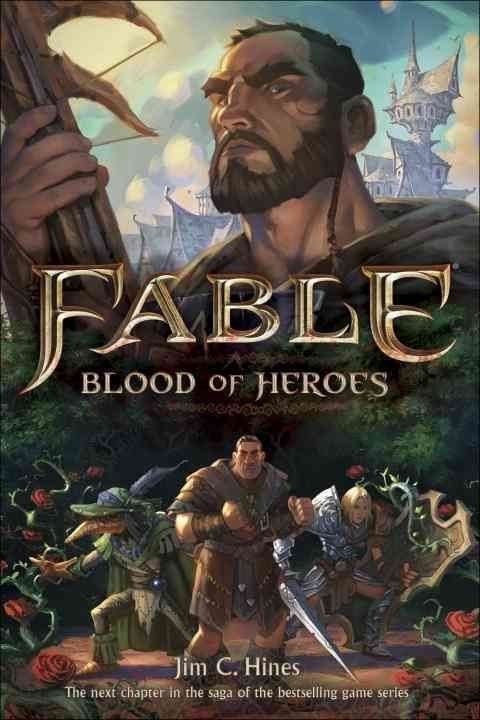- Fable: Blood of Heroes
- Jim C. Hines
- Published by Titan Books
- £7.99
- Book provided by the publisher
Fable Legends may not be out of beta yet, but it already has its very own tie-in novel. Blood of Heroes is written by Jim C. Hines and, while you may not have heard of him, he does have previous experience writing comic fantasy stories. That’s the most important point to make; the Fable series is traditionally associated with a strong sense of humour, and this book has very much been written bearing that in mind. What would likely have been the worst mistake (playing things po-faced) has been avoided – but where does the book go from there?
The book, like the game, is set long before the events of Fable 1-3. This rather conveniently means that there’s little worry of contradicting events or character traits seen in the main games. What it doesn’t explain is the absence of the element that’s arguably associated with Fable immediately after its sense of humour; the idea of choice, usually the choice between good and evil actions. How well choice is or is not implemented in the games is another issue, but it’s there. On the one hand, it’s a theme that could have worked excellently in a novel; on the other hand, it’s not a theme that seems to be at all important to Fable Legends, and that’s the game this book is specifically supporting.
Hines has, presumably under strict instructions, used the game as a template for the novel’s world at every opportunity. Places from Legends appear in Blood of Heroes, as do certain enemies. The eponymous Heroes are lifted directly from the game, in terms of both character class and even name and hazily-sketched personality. There’s plenty of room for Hines to flesh out the details and make the Heroes his own; but he never achieves this in the way that you might hope. Due to a combination of pre-existing character traits and an unfortunate willingness to settle into fantasy fiction stereotypes, each Hero is distinct but sadly unremarkable. The worst offender is Tipple, a heavily built and inhumanly strong bare-knuckle-brawling-jolly-and-uncouth-but-good-hearted drunkard that you’ve seen, heard, and read about a thousand times before.

This is Sterling, and Hines does a great job of creating a mind’s-eye version of him.
You can probably guess at the plot with fair accuracy without any hints. The land of Albion is under threat from a diabolical plot with a single mastermind. Magic is involved. It’s up to the Heroes to go forth and, working together, kill things and save people until the danger is gone. There’s a plot twist you quite possibly won’t see coming about two thirds of the way through; but in honesty, this is largely because of withheld information, and the exact (and very important) details of the related past event remain hazy.
Unsurprisingly, the Heroes win out in the end. This is worth remarking upon when discussing the book because, as is made clear at an early stage, Yog – the witch determined to bring woe unto Albion for reasons that are never made entirely clear – is not only powerful, but also extremely difficult to kill. This is due to a very specific reason that (a) to give credit where it’s due is eventually explained well enough to understand, and (b) entirely contradicts the method with which the Heroes claim their victory over the witch in the end. The initial reveal of Yog’s weakness is something of a plot hole in itself, but still…
In more general terms, while taking a humorous approach to the writing was absolutely the right call, it’s an unfortunate fact that most of the jokes, well… aren’t funny. It’s not tediously unfunny, and it is funny on occasion. The best line is perhaps “He was shouting, assailing her with pent-up pain and outrage, along with the occasional spray of spittle. It was as if she had killed his beloved dog, then used the body to kill his other, even more beloved dog”.
So as you can see, there are some strong parts in there. Overall however the humorous approach merely creates a lighthearted approach to storytelling – which is no bad thing. Bad fantasy tends to fall over itself with unwarranted seriousness and obstinately named characters and places. Much can be forgiven when this cringeworthy writing style is wisely avoided.

Yet another fantasy doctor wearing a beak mask.
Although characterisation is almost exclusively generic and disappointing, there is one exception. Blue is a ‘redcap’, what looks to be generic blade/arrow/magic fodder in the game. By using one as a main character in his novel, Hines has allowed himself plenty of room for manoeuvre in his creation of one of the story’s main personalities. Blue is unrepentantly self-serving, mischievous, and utterly unpredictable; making him easily the most interesting character in the novel. There’s more than a touch of Smeagol about him, but he’s far from a carbon copy. Is this a hint at what Blood of Heroes could have been with less tie-in restrictions?
All of this leaves the book in an odd place; who’s the audience? Existing fans of Hines’ work will doubtless be pleased, but who beyond that? You don’t need to have played any Fable game to understand the plot (though there are a few subtle references to the established, digital Albion). If you gobble up anything fantasy and/or Fable related at every opportunity, then you could do a lot worse than this. If you’re more selective in your reading, however, the truth is that you could do a lot better, too.



Comments